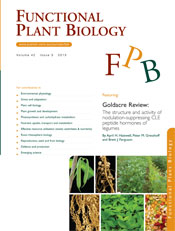
Functional Plant Biology
Volume 42 Number 3 2015
FP14222The structure and activity of nodulation-suppressing CLE peptide hormones of legumes
CLE peptides are critical regulators of plant development, and include members that control legume nodule numbers in symbiosis with nitrogen-fixing rhizobia bacteria. These peptides are essential for the host plant to maintain a balance between acquiring nitrogen and expending energy forming and maintaining nodules. The structure and function of all known nodulation-suppressing CLE peptides is the focus of this review.
FP14171Auxin-modulated root growth inhibition in Arabidopsis thaliana seedlings with ammonium as the sole nitrogen source
Ammonium and NO3– are the major nitrogen sources of plants. Although NH4+ is preferred, plant growth is suppressed at higher concentrations. Here, the transcriptomes of seedlings grown on (NH4)2SO4, KNO3 or NH4NO3 were compared. A major difference in auxin-regulated genes was observed and the importance of auxin was confirmed using mutants in the auxin pathway.
FP14209Linking osmotic adjustment and stomatal characteristics with salinity stress tolerance in contrasting barley accessions
Soil salinisation is a global issue that affects plant growth and limits agricultural production, and a comprehensive understanding of the mechanism of salt tolerance is essential for breeding salt-tolerant genotypes. Our results indicate that higher stomatal density and a predominant use of inorganic osmolytes are critical for the osmotic adjustment when barley exposed to salinity stress. These findings offer breeders new phenotyping methods for screening salt-tolerant genotypes, and provide a new insight into mechanisms of salt tolerance in this species.
FP14172Water relations of an invasive halophyte (Spartina patens): osmoregulation and ionic effects on xylem hydraulics
Invasive plants pose serious risks for conservation of coastal habitats. Spartina patens revealed physiological mechanisms based on salt uptake and accumulation, and ability to control the capacity of the plant to transport water, thus allowing colonisation of both dunes and marshes. Studies are needed to investigate the eventual occurrence of similar mechanisms in native species outcompeted by alien ones.
FP14190Isolation and functional characterisation of CDPKs gene from Arachis hypogaea under salt stress
Calcium-dependent protein kinase (CDPK) is an important member of Ca2+-signal transduction pathway for plants to resist environmental stress. We cloned a peanut CDPK gene to analyse its function. The over-expressing AhCDPK improved resistance of tobacco to salt stress. Our results will help improve peanut salt resistance and further expand its cultivation in saline-alkali soils.
FP14177Metabolomics deciphers quantitative resistance mechanisms in diploid potato clones against late blight
Potato production is threatened worldwide by late blight disease, which destroys crops and lays a heavy financial burden on producers. Diploid potatoes with high disease resistance were analysed for the first time to identify the resistance related metabolites and associated genes responsible for impeding the pathogen. Phenylpropanoids, flavonoids, fatty acids and alkaloids induced reinforcement of secondary cell walls deterring pathogen advancement, and the genes involved can be used in breeding following validation.
FP14125Intraspecific variation in leaf growth of wheat (Triticum aestivum) under Australian Grain Free Air CO2 Enrichment (AGFACE): is it regulated through carbon and/or nitrogen supply?
Increased plant growth and yield response to elevated [CO2] is closely associated with leaf area expansion. The main aim of this study was to investigate the mechanism of leaf area expansion and its genetic plasticity. Our results suggest that carbon supplies to growing leaves are cultivar dependent, and well correlated with leaf area expansion and whole-plant growth.
FP14208Seasonal changes in the photosynthetic response to CO2 and temperature in apple (Malus domestica cv. ‘Red Gala’) leaves during a growing season with a high temperature event
Extreme summer temperatures are increasingly frequent and are known to cause a loss in crop productivity. The aim was to test the photosynthetic performance of economically important Malus domestica (apple) trees under these conditions and discovered that extreme heat compromised the photosynthetic process but recovery occurred when the temperatures subsided. These results provide a basis for comprehending the impact of climate change.
FP14025How different pruning severities alter shoot structure: a modelling approach in young ‘Nonpareil’ almond trees
Pruning clearly influences subsequent growth and structure of trees; however, systematic studies on shoot structural responses to pruning severity have been difficult due to shoot structural complexity. This research used a statistical modelling approach to characterise shoot structural responses to pruning severity in ‘Nonpareil’ almond trees. Shoot responses to pruning were relatively consistent and predictable among similar shoot types within pruning treatments while pruning severity increased shoot structural complexity.



